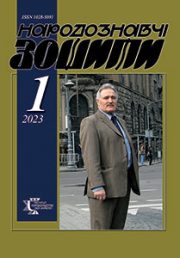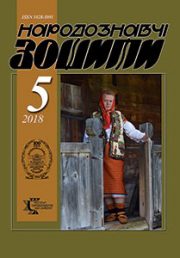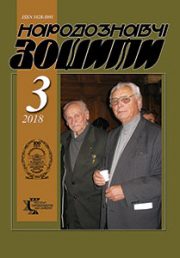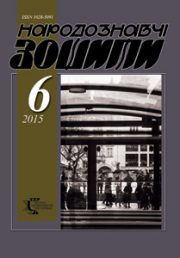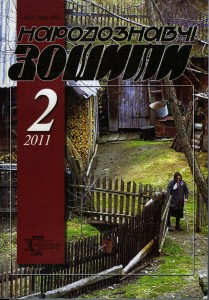2011 year, issue 2
Content
In the article are considered some peculiarities in formation of Ukraine’s identifying space of late XX and early XXI cc. with particular analyzing of perspectives for church participation in making the Ukrainian civil nation under conditions of multi-confessional society. The author tries to unite macro- and micro-approaches paying special attention to analysis of contemporary Ukrainians’ everyday life experience according to her own vast empirical research data.
Keywords: identifying space, religion, model of national (state) church.
Keywords: identifying space, religion, model of national (state) church.
Ivashkiv Vasyl. Folkloristic expeditions of Panteleymon Kulish in the 1840s. P. 200-206
In the article have been analyzed main aspects of Panteleymon Kulish’ folkloristic activities in the 1840s, viz. some materials of his ethnological expeditions in the territories of then-a-day Kyiv province. Studies on handwritten expeditional materials, which are kept in Kyiv and Chernihiv archives, gives an opportunity of penetration into folklorist’s laboratory, to throw light upon peculiarities of his way of recording folklore texts, to trace the routes, to read about the people whom he asked about folk customs and traditions and from whom recorded eternal folk-poetic works.
Keywords: Panteleymon Kulish, folkloristic expedition, recording folklore works.
Keywords: Panteleymon Kulish, folkloristic expedition, recording folklore works.
Romaniuk Volodymyr. Beliefs of hunters in the Ukrainian Carpathians. P. 207-214
In this paper the author brings results of his studies in beliefs of hunters. This field of Ukrainians’ spiritual culture has not investigated as for now. The author has fulfilled some scientific descriptions and analyses of rites and rituals of hunters in the Ukrainian Carpathians. Acts mentioned by author the hunters had done with the aim to ensure accurate shots and to protect guns from hostile magic. The author has elaborated a classification of these rites. The investigation of hunters’ rites is a kind of addition to the general research of pre-Christian beliefs of Uk¬ra¬inian nation.
Keywords: belief, rite, ritual, traditional hunting, Ukrainian Carpathians.
Keywords: belief, rite, ritual, traditional hunting, Ukrainian Carpathians.
In the article is considered quite spread among classical authors of Ukrainian belles-lettres a phenomenon of turning to motives for reflection of images and activities by loggers and rafters in Carpathians. Numerous examples have been systematized in chronological order after appearance of corresponding literary works with discovery of creative, methodological and stylistic differences in approaches by various authors. Scientific observations have been illustrated with fragments of texts by Y. Holovatsky, M. Ustyianovych, I. Franko, I. Nechui-Levytsky, H. Khodkevych, M. Kotsiubynsky, B. Lepky, V. Grendzha-Donsky and oth. Analytical study has been presented as for artistic and aesthetic methods by means of which the writers discover corresponding aspects of Ukrainians traditional mode of life.
Keywords: ethnical history, household activity, mode of life, customs and rites, logger, homecraft, world-view and world-feeling.
Keywords: ethnical history, household activity, mode of life, customs and rites, logger, homecraft, world-view and world-feeling.
Horbal Maria. Christmas ritualism of Lemko land: some factors of formation. P. 236-244
The article throws light upon some factors that had been favorable to formation of Lemkos’ Christmas ritualism, viz. spiritual richness of Pagan culture, Christian doctrine, influence of Ancient World culture as Byzantine, Greek-Roman, ones of Near East and Scandinavian nations. Especial attention has been paid to trade routes that led through Lemko Carpathians and enabled multinational cultural interrelations.
Keywords: mythology of proto-Ukrainians, Christian world-view, Kyivan Rus’, cultural influence, trading routes.
Keywords: mythology of proto-Ukrainians, Christian world-view, Kyivan Rus’, cultural influence, trading routes.
Imre Lakatos’s positivistic methodology has been adapted to the analysis of historical (ethnological) structures. Distinct core structure as scientific idea has been identified with the distinct core structure as fragment of informative reflex. It is preserved against destroyment with «protective zones», which create information blockages for true distinct core search. At the same time these can serve as indicators pointing at the distinct core structures. It is accepted that historical (ethnological) processes are of wave nature, and the inductive empathy method has been used in analyzing of those. The distinct core extraction procedure has been described on the basis of «Derision of Young Mazepa». It has been discovered that this structure fits the old «Path of the Magi» structure in the form of «Heavenly Chariot — 5». «King Hippolytus’s Death» and «Yusuf and Zulaikha» are its analogues. The calculations made show that such structures move northwards.
The «Path of the Magi» structure reflects relations building processes between the main ethnos and assimilated ethnic groups.
Keywords: Mazepa, post-positivism, inductive empathy method.
The «Path of the Magi» structure reflects relations building processes between the main ethnos and assimilated ethnic groups.
Keywords: Mazepa, post-positivism, inductive empathy method.
Halchak Bohdan. A mystery of a lurking-place near Balihorod. P. 255-261
On the ground of previously unknown documents a refutation is made of officially adopted by Polish historiography version of reasons for «Wisla» action.
Keywords: «Wisla» action, Karol Swierczewski, partisans of Ukrainian Insurgent Army.
Keywords: «Wisla» action, Karol Swierczewski, partisans of Ukrainian Insurgent Army.
The article deals with Ukrainian pottery predestinated to be used in ritual and festival circumstances. Author has separated earthenware items in a conventional group. She presents the range of ones and gives some characteristic features for each kind of those. Attention has been paid to the ways the Ukrainians made use of earthenware during preparation and celebration of both most honorable Christian festival — Christmas and Easter.
Keywords: Earthenware, pot, basin, plate, Easter cake pot, pig box, Christmas, Easter, Opishne, Poltava Region.
Keywords: Earthenware, pot, basin, plate, Easter cake pot, pig box, Christmas, Easter, Opishne, Poltava Region.
Traditional techniques of treatment and storage of grain in Yavoriv area in the first half of the 20 century have been studied on the bases of data got from local informers. It has been established, that traditional tools characteristic of the majority of regions of Ukraine were there used, as thrasher, mortar, grindstone, «mlynets’» («small mill»), a small wooden shovel for winnowing called also «shufelky», «sidlyachky», «silyachky». The local peculiarity of Yavoriv area was the local measure for grain – a bal that has not been found anywhere else in ethnographic research-works. In some aspects this study brings additions to earlier ethnographic works on such important and still insufficiently known etnographic territory of Nadsyannya (territory in the basin of the Syan river) as Yavoriv area.
Keywords: treatment, storage, Yavoriv area, mortar, grindstones, shovel, corn-bin, wooden barrel, wicker straw baskets, boxes.
Keywords: treatment, storage, Yavoriv area, mortar, grindstones, shovel, corn-bin, wooden barrel, wicker straw baskets, boxes.
In the article are developed some peculiarities in celebration of New Year Day in the village of Voroblevychi, Drohobych region, Lviv county; among other festive events is presented unknown as for now in ethnology New-Year Youthful game, a Tripak.
Keywords: New-Year celebration, Old (Julian) New Year, youthful play, group acting.
Keywords: New-Year celebration, Old (Julian) New Year, youthful play, group acting.
Syriamina Natalia. On artistic analogies of megalithic constructing. P. 284-300
The article brings author’s philosophical understanding of place/role variables as determinants for the process of development of prehistoric artistic culture in creative potencies by human’s consciousness. In scientific circulation has been introduced quite innovative approach to interpretation of graphical signs used in megalithic construction as well as conceptual treating of a sign system – a set of data that lead to comprehension of their predestination, viz. to spreading of intellectual information. In epoch of high Neolith, this information was transformed in the art-ethnical and semantic forms. The author suggests a kind of categorization for signs of four divisions. Besides, the article presents a concerted review in typology, which enables identification of signs, no matter of accommodation area.
Keywords: megalithic construction, megalithic art, graphical signs, solar signs, geometric signs, anthropomorphous and zoomorphic signs.
Keywords: megalithic construction, megalithic art, graphical signs, solar signs, geometric signs, anthropomorphous and zoomorphic signs.
The article deals with some problems in the history оf Ukrainian feminine monasteries at Lviv. On the basis of temple visitations of 1776—1805 in Basilian Sisterhood Monastery of Entry of the Most Holy Theotokos into the Temple has been performed a comparison in interiors of monastery church. In the study has been considered an iconostasis that survived until now at the church of St.Demetrios in Zboishche region in Lviv surroundings. The author accentuates artistic features in most ancient part of ensemble that has originated from the Monastery of Entry of the Most Holy Theotokos into the Temple (1720—1733).
Keywords: church visitations, Lviv Monastery of Entry of the Most Holy Theotokos into the Temple, iconostasis..
Keywords: church visitations, Lviv Monastery of Entry of the Most Holy Theotokos into the Temple, iconostasis..
Public opinion is viewing a space organized by means of architecture with the notions of Euclidian geometry and rectangular system of co-ordinates. Nevertheless the language of architectural forms as good as each other one possesses some special additional meaning as associative values, symbolic sense etc. In Baroque epoch these notions play quite a particular part providing the objects with certain nominality.
Keywords: form, space, Counterreformation, Baroque, semantics of a form.
Keywords: form, space, Counterreformation, Baroque, semantics of a form.
The article is based upon actual and growing need in preservation of monumental artistic creations of late17th and 18th cc. in Galicia. Bright example of such a problem is being presented by contemporary state of St. Bernard monastery temple. In the article are examined several problems of chronology and descriptions based upon some data on development of monumental painting in Galicia. The article brings the analysis of the art-and-style peculiarities of decorations in St. Bernard temple.
Keywords: Baroque, art-style peculiarities, altar, nave, place for presbyter, al fresco, restoration.
Keywords: Baroque, art-style peculiarities, altar, nave, place for presbyter, al fresco, restoration.
Rudenko Oleh. On handwritten books in Modest Sosenko’s creativeness. P. 327-331
In the article is considered an influence of Ukrainian handwritten books upon formation of national motives in monumental creativeness by Modest Sosenko, an outstanding Ukrainian artist on the edge of XIX and XX cc. Especially important task of the article is presentation of ways in which miniature elements of manuscript designing had found their interpretation and development in artist’s paints.
Keywords: handwritten book, manuscript, Secession, monumental paintings, folklore ornamentation.
Keywords: handwritten book, manuscript, Secession, monumental paintings, folklore ornamentation.
Trumko Dzvenyslava. On a role of compaternity in natal ritualism. P. 332-337
In the article is considered a role of godparents in natal ritualism, some peculiarities in selection of persons to become godparents as well as relations between godparents and baby’s parents, between godparents and a christened child, between godparents themselves. Light has been thrown upon protective ritual acts preordained to keep baby’s welfare in future, to protect him against all evils in his life.
Keywords: godparents, baby, child, parents, baptism.
Keywords: godparents, baby, child, parents, baptism.
This article brings investigation and analyses of Ukrainian soldiers’ creative approaches to a problem of military uniform as well as different variants in connections of Ukrainian and Caucasian national costume features in Ukrainian uniform, the usage of attributes, accessories, and elements of Caucasian folk clothes, an original approach to modeling and designing of «Cherkeskas» (Chircassian battle-dresses) during the national revolution of XX c.
Keywords: Military clothes, uniform, the military form, a Chircassian, beshmet, arhaluk, bashlyk, felt cloak, papakha, harmony, colour gamut, a composition, national traditions.
Keywords: Military clothes, uniform, the military form, a Chircassian, beshmet, arhaluk, bashlyk, felt cloak, papakha, harmony, colour gamut, a composition, national traditions.
The article is devoted to role and place of humour in heroic struggle of the Ukrainian people exemplified by Hryhorii Hrabyanka’s Chronicles.
Keywords: Ukrainian folk humour, Ukrainian Cossacks, annals by Hryhorii Hrabyanka.
Keywords: Ukrainian folk humour, Ukrainian Cossacks, annals by Hryhorii Hrabyanka.
Holubets Halina. Professional tandem. P. 350-353
The article is devoted to a recently published scientific and artistic edition «P. Linynsky’s collection of ceramics» by Halyna Ivashkiv. The author has brought thorough analysis Ukrainian ceramic artifacts found, collected, restored and reconstructed by Petro Linynsky through his 40 years-long passionate collectorship. The collection comprises stove tiles of 14—18th cc., ceramic objects of archaeological cultures, decorative and applied art-works by famous Ukrainian ceramic centers of 14—20th cc, as well as fragments of tiles and crockery which are not restorable.
Keywords: Ukrainian ceramics, Petro Linynsky, ceramic tiles, collection.
Keywords: Ukrainian ceramics, Petro Linynsky, ceramic tiles, collection.
Under conditions of transformations and rapid disappearing of traditional cultural phenomena there is a growing need in retrospective studies that might to enable a determination of artifacts as for level of conservation, transfomation and development. The aim of present paper is a research-work in traditional culture by the inhabitants of the village of Mshanets and its surroundings as well as in the sphere of folk architecture, as well as evaluation of the completeness of materials registered by M. Zubrytsky from a distance of more than a century and some additions to ones.
Keywords: ethnical culture, traditional culture, folk architecture, traditional habitation, custom, ritual.
Keywords: ethnical culture, traditional culture, folk architecture, traditional habitation, custom, ritual.
Mykhailo Hlushko. Good memory of Vasyl Domanytsky will not fade. P. 365-367
read »
